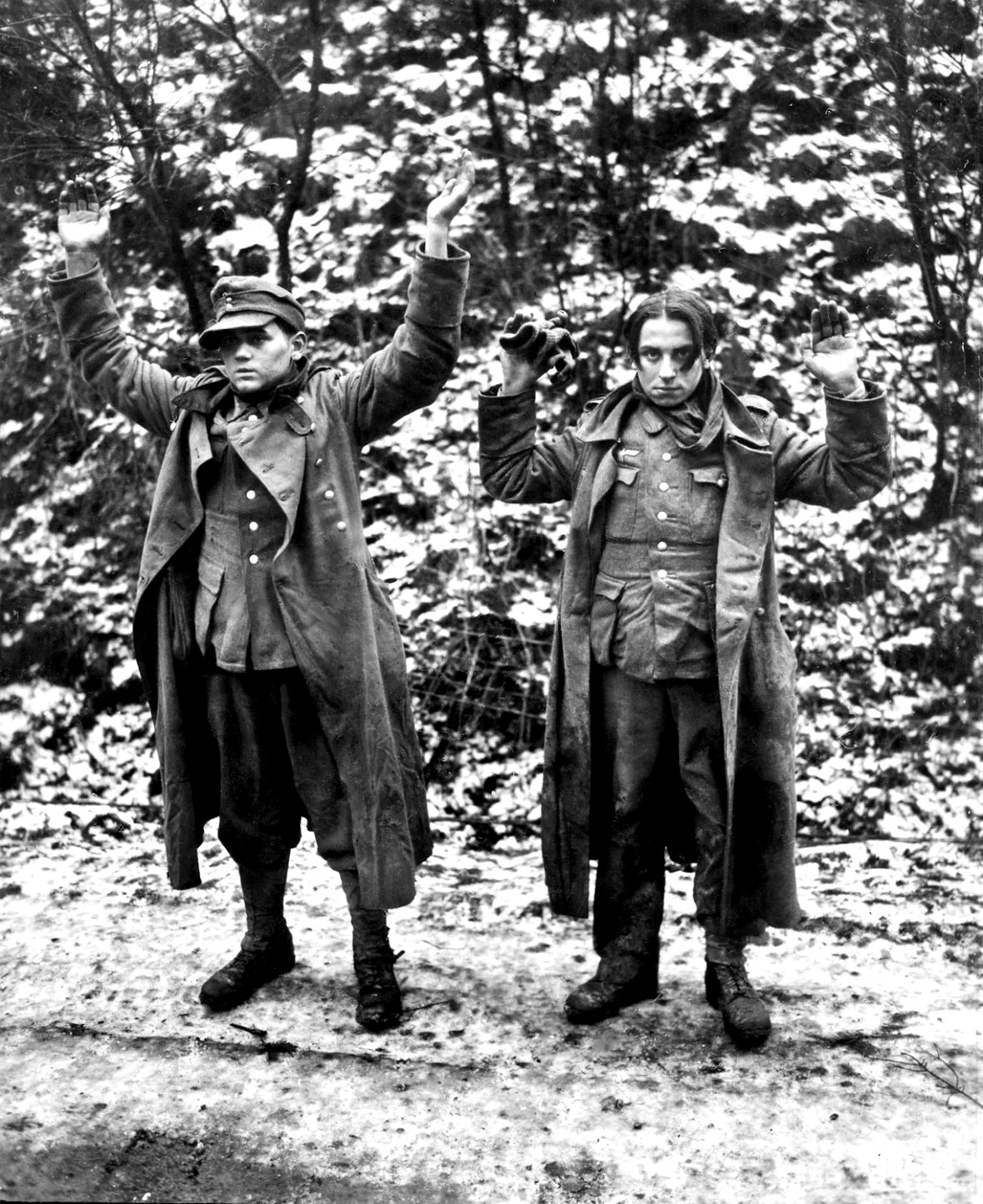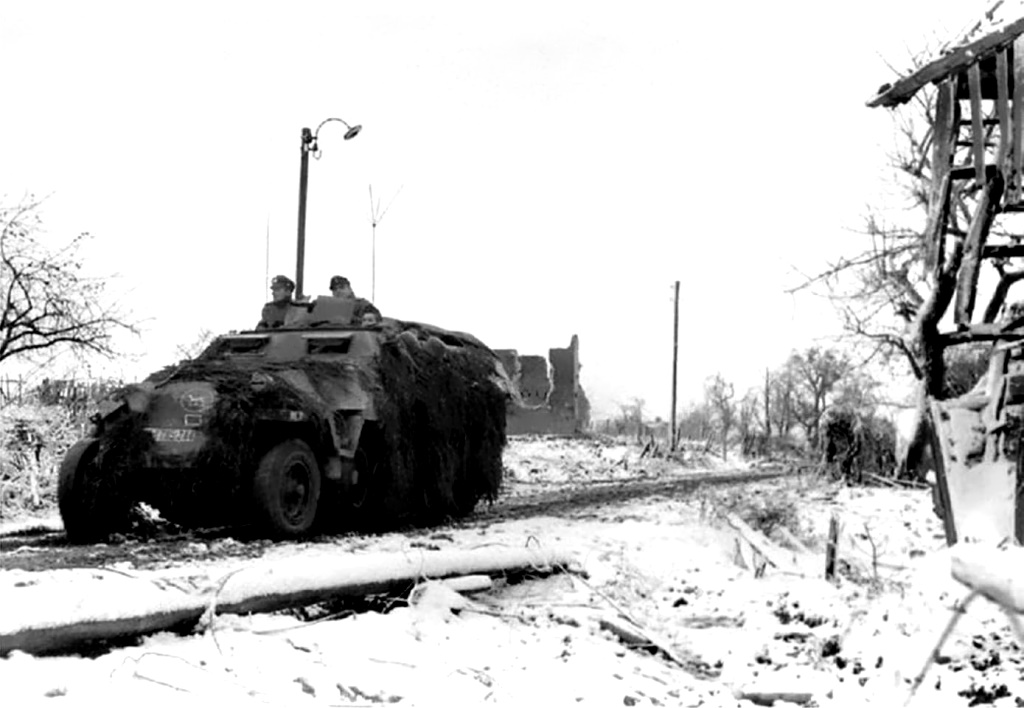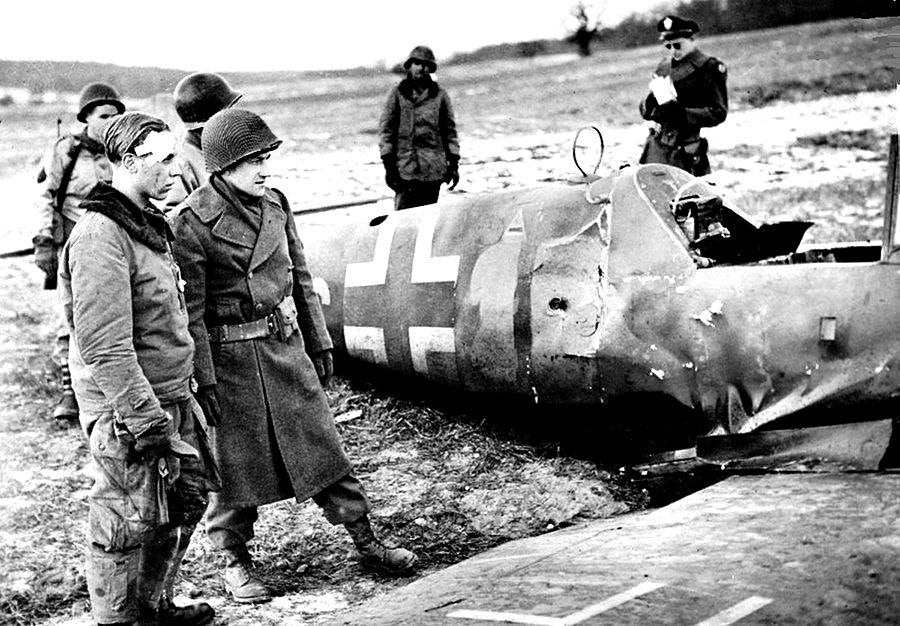At 0940, an undetermined number of panzer grenadiers had forced through our lines, splitting Able and King Cos 26-IR. Elements of the 18-IR were committed to holding further penetrations, Baker Co 26-IR, advanced to restore the ground and Able Co attacked due east to close the gap. Later, around 1600, elements of the 18-IR moved in and helped in retaking the ground. One tank was still behind our lines after the fighting was over, but managed to escape after dark. This second attack was equal in intensity to that of the 25.PGR the day before and was, in the end, equally disastrous to the enemy. Beyond his failure to reach the promised land of his northern road net, he lost well over twenty tanks, and his casualties, although uncounted, ran into crippling figures. Patrols sent out on December 23 reported enemy dead as common as grass, with corresponding amounts of abandoned equipment. For the two days of fighting it was estimated that the enemy lost more than 44 tanks — more than 44 since that number was actually seen and counted. The 26-IR estimated that it had inflicted over 1200 casualties on the enemy. With the collapse of his plan to force his way north, the enemy subsided into the defense, bringing up infantry units to hold the line while he withdrew the 12.SS-PD for repairs. Movement in front of the Division was heavy but undetermined in purpose; the most significant report of December 23 was that horse-drawn equipment was observed moving across the Division sector indicating the arrival of purely infantry units. Small attacks came in against the 16-IR and the 26-IR, but they were obviously intended as holding efforts rather than serious attempts at penetration. Two more enemy tanks were knocked out in the vicinity of Büllingen.
From December 23 to the end of the period, the enemy continued to bring in infantry elements to replace his armor and to build up an artillery concentration, both field and anti-aircraft, southeast of Büllingen. Movement on the limited road net in front of the Division line continued heavy, and was taken under punishing artillery fire, but rather than indicating a new formation for an attack, it proved to be traffic supplying the deeper penetrations of the enemy salient, driven off the main roads by our air attacks. The Division prisoner count dropped to practically nothing; those who were taken were usually lost and snared on our minefields. Division patrols moving to the front were often able to penetrate 1000 yards before contact, and from their reports, it was evident that the enemy was digging in and preparing to defend.
On December 26, prisoners and documents indicated that the 3.FJD still held the western flank of the Division’s front; to the east, it was believed that the 12.ID had moved into line. On December 28, this belief was confirmed. Shortly before dawn the 3.Bn of the 27.VGR (12.ID) attacked the left flank of the Division positions after an intense artillery and Nebelwerfer barrage. The plan was ambitious. The 1.Bn of the 48.IR, was to make a simultaneous attack to secure the high ground west of Wirtzfeld, and elements of the 246.VGD, previously identified in front of the unit on the left of the Division, were to push through to Elsenborn from the east. Despite these elaborate plans, the attack was a complete fiasco. The 3.Bn of the 27.IR, was taken under intense artillery fire during its approach march and a high percentage of the Volksgrenadiers reversed their field and moved rapidly to the rear. Some elements of the 9.Co and a handful of engineers from the 12.EB succeeded in infiltrating up the draw northwest of Büllingen; they remained ineffective during the day and were combed out by strong combat patrols before dark. The attacks of the 1.Bn of the 48.IR, and the elements of the 246.VGD was equally discouraged, and the net result of the day’s work was the capture of three men from the 53.Nebelwerfer-Regiment which had supported the attack, thus giving a source for much of the Nebelwerfer fire which had been falling on the Division positions during previous days.
The failure of his last ambitious attack apparently convinced the enemy of the futility of trying to force his way through our defenses. Enemy activity to the end of the period as reported by patrols, consisted only of busy digging and moderate counter-patrolling. The enemy continued to lay artillery fire on our forward positions and extended his efforts to interdiction of roads in the rear areas. To what extent the stand of the 1-ID southeast of Bütgenbach put a spoke in the wheel of the enemy’s plan is an open question. Certainly the enemy, from the high priority he placed on getting through to the northwest and his successive all-out attacks, considered it of primary importance. The stand, moreover, was disastrous to the enemy in a negative way. On the positive side, he had two regiments of one of his top-drawer SS panzer divisions ground down to a framework and lost up to 60 tanks in addition. On the negative side, however, he was unable to come to rescue the 1.SS-PD caught in a vise in the Stavelot–La Gleize area by the 30-ID. And, possibly most important of all, he was forced to rearrange his high-level plan completely, abandoning the idea of getting at the US 1-A dumps in the Verviers & Soumagne areas.
As a result, the II.SS-Panzer-Corps, which was to follow up the successes of the I.Panzer-Corps, was committed to the south instead. With the 1-ID jutting out into the salient, the overloaded road net supplying the point of the thrust was further restricted in the radius of artillery fire. Altogether, the northern flank of the German penetration was not a matter of heart-warming satisfaction to the German High Command. If the enemy had failed to gain his ground, certainly he had tried hard enough with every means at his command. Treachery and deception played an integral part in his plan. The tactic of the 150.PB (the power behind Operation Greif) was never fully successful due to greatly increased security measures taken by the Division. Although no established penetrations of Germans in American uniforms, Einheit Stielau, took place in the Division zone, an idea of the effectiveness of control can be had from the case of a strange officer from higher headquarters who got lost on his way to one of the regimental CPs and ended up on a road leading through one of the front-line company positions. Within an hour of the first alarm, the officer had been arrested four times and checked for identity. Treachery had an equally important part in the enemy operation.
A number of American prisoners taken by the 1.SS-PD southwest of Malmedy on December 17, were disarmed and shot by their captors; more than 25 Belgian civilians were murdered in Stavelot by the same unit. On December 26, a three-man enemy patrol entered the lines of the 16-IR with the indication it wanted to surrender. It was discovered, however, that one of the enemies was carrying a P-38/40 machine pistol behind his back. The patrol was eliminated. Enemy artillery during the period was consistently strong, although it reached the intensity of the Hamich Woods only on a few occasions before an attack. At the end of the period, a considerable artillery build-up was still reported southeast of Büllingen. During the operation, the Luftwaffe put in an appearance of greater strength than the Division had encountered since the European Campaign started. Enemy air attacks were frequent but not very productive; the highest number of enemy planes reported over the Division area at one time was 30. The enemy air situation was further confused by the appearance of American P-47s which committed hostile acts and were believed to be enemy-operated; it was later learned that the planes were American and that the fault lay with the pilots’ briefing.
During the night of December 19/20, the 26-IR received a heavy armored and infantry attack on its left flank. The attack, which started at about 2300, continued in varying degrees of intensity throughout the night and until about 0800. An hour later a second attack, at the time believed to be a continuation of the first, came in on the right flank of the 26-IR. After the attacks had subsided, the 26-IR estimated that it had knocked out six tanks. During the morning of December 24, a courier, apparently lost, ran across a minefield laid by the 16-IR in a tracked motorcycle and blew up. The courier was carrying the document below. The report deals with the attack on the left flank of the 26-IR, and it is evident that considerably more than the estimated six tanks were knocked out by our fire. The infantry mentioned is believed to be the 2/25.PGR; the paratroopers were probably from the special (z.b.v.) (zur besonderen verwendung – for special use) paratrooper regiment attached to the 150.PB. The later attack on the right flank of the 26-IR was launched by elements of the 3.FJD.
3/12.SS-PR – Bn CP, December 23, 1944 (Combat Report for Period 18/23 Dec 1944)
After the night attack on Krinkelt during the night of December 18/19, the battalion was ordered back to its starting position on orders from the regiment. The battalion, less the 11.Co, reached the highway in the wooded area vicinity points 639 and 672 at 2400. The 11.Co, which, together with 5.Co, had remained at the northeastern edge of Krinkelt for security, was also pulled back into the wooded area later during the night. Losses in the night attack: 1 Mark IV belonging to 10.Co became a casualty when it hit a mine and another Mark IV belonging to 11.Co was damaged by a Sherman tank during the night fighting in the town (damage to tracks). One officer of the 11.Co was slightly injured by shrapnel. Accomplishments: 1 Sherman was put out of action by 11.Co, 10 prisoners were taken. After replenishing its gas and ammunition supply, the battalion was to assemble at 0500 and start its advance on Bütgenbach via Losheimergraben–Büllingen. Because of difficulties in connection with refueling and the clogged highways, the battalion’s point reached the road near (left out of original) at 1200. The battalion commanding officer, together with his liaison officer, went ahead to Büllingen in order to reconnoiter terrain and situation and establish contact with elements committed there. After being briefed by SS-Hauptsturmführer Urabel (3/26.SS-PGR), the battalion was oriented as follows by the commanding officer of the advance elements of the 12.SS-PD, Maj (Wehrmacht) Meier: I reached Büllingen which had already been taken for one or two days.
The exact date slipped my mind; it can, however, be established by further inquiry. I was then stopped by my division in spite of my suggestion to penetrate Bütgenbach without delay, lest the enemy gain time to bring up reserves and establish a strong line of defense. Maj Meier further explained that the enemy had strengthened himself continually during the preceding day, that he had dug in, and thus established a defensive line in the vicinity north of Büllingen, (Domaine Bütgenbach), to the edge of the woods southwest of Domaine Bütgenbach (Morscheck).
After the report concerning the situation at Büllingen had been given to the Regimental Commanding Officer in the Division Commanding General’s presence, the latter gave instructions concerning further plans. The alerted battalion moved as follows: 10.Co with Engineer Platoon, 9.Co, 11.Co, Parts of Headquarters Co. As the infantry reached its first objective west of Büllingen only at 2300, the battalion started its attack 10 minutes later. In the darkness, the tank point, instead of advancing in a westerly direction, advanced towards the southwest; yet it was possible to halt it and direct it to the correct road. In the meantime, the liaison officer had found out that the infantry was still on both sides of the road about 800 meters west of the road junction at the western entrance into Büllingen. Slowed down by the pace of the infantry, the attached paratroopers, and mine detector squads, the point made halting progress only after the security lines of the infantry, paratroopers, and engineers already committed in that area, had been passed by about 220 meters, heavy AT fire from the left (Domaine Bütgenbach), as well as exceedingly heavy artillery and mortar fire was encountered. The infantry suffered the most serious losses as a result of this fire and the accompanying heavy rifle and enemy machine gun fire. The attack failed before the point could be fully committed, as several vehicles were in bad shape because of artillery and mortar hits. The company was withdrawn by the commanding officer, and the battalion was regrouped.
At about 0500, the battalion, on both sides of the highway, renewed its attack with the 9.Co (Jagdpanther) as the point. It penetrated the foremost AT defenses, but the commanding officer and his tank were hit. The commanding officer took his burning command tank to the rear and took the command tank of the 11.Co, which he led during the attack. In the meantime, the 9.Co, in spite of the extremely heavy AT fire, had penetrated to the high ground west of Domaine Bütgenbach and was engaged by superior enemy forces, which put three of eight tanks out of action. The 9.Co, engaged in that vicinity, was exposed to extremely heavy artillery and mortar shelling.
The 11.Co, which had been brought up in the meantime, received heavy AT fire from the right flank, and the command tank with the battalion commanding officer, received a direct hit and started to burn. Other tanks were damaged by artillery and AT fire. As the 9.Co was unable to advance further, and the point was pinned down, the commanding officer decided to discontinue the attack. There was no further hope of success, and friendly artillery was unable to diminish the enemy’s artillery fire. The battalion was taken back into its starting positions. Refueling, repairs, and receipt of ammunition could not be accomplished in Büllingen as originally planned. For that reason the US artillery having zeroed in on the town, the battalion was taken two kilometers to the rear to the vicinity of Tiefenbach.
Since very few elements of the battalion were left (3 Jagdpanther and 10 Mark IVs), they were consolidated under SS-Hauptsturmführer Wewers in order to take part in another attack on December 21. During that action, the battalion’s liaison officer, SS-Untersturmführer Fritsch, was killed by a direct AT hit on his tank. Detailed reports about that action will have to follow, as SS-Hauptsturmführer Wewers has probably been killed and the situation will have to be cleared up through further inquiry. The same is true of the attack on Schoppen on December 22, 1944.
(Illegible Signature)
(Interview with Doc Snafu – 1986 (Extract)
Pfc William E. Mueller, AAA-AW Bn, 2nd Infantry Division, Krinkelt Rocherath
“Between December 1 1944 and December 26 1944, we shot down 19 airplanes …, 12 were German …”
Additional Sources I used for this Archive
ETO History (Bill Warnock)
Snow and Steel
Battle of the Bulge – Scale 1/10
The Hangar Deck – Piper L-4
Army Air Force – Winter 1944
Elsenborn Ridge, the battle
Relief At Capture For A German Paratrooper (Lea Rose Emery)
Battle of the Bulge Memories
























